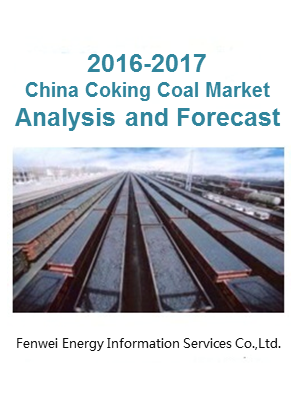
Cycle of publication: Annual
Date of completion: Jan 26, 2017TOTAL: US$ 2000
Online Self-purchase
Part 1: 2016 China Coking Coal Market Review
1 Demand Side: stabilizing economic growth, and recovering investment intoreal estate and infrastructure driving up growth of steel demand
1.1 Macro-economic background (GDP, FAI, IVA, PMI and investment of real estate and infrastructure showing signs of stabilizing)
1.2 Recovering demanddrove more-than-expected steel and coke production
1.3 Steel exports dipping from high level, coke exports hitting new high since 2009
1.4 Effective destocking effort: steel and coke stock remaining on downside
1.5 Recovering demand, supply-side reform and pressure from environmental protection boosted steel and coke prices vigorously rebounding from low level
1.6 Washed coking coaldemand realizing positive growth
2 Supply Side: from decapacity and cutting production to guaranteeing supply and stabilizing price
2.1 Supply-side reform: to help coal companies out of difficulties by resolving overcapacity and reducing production
2.2 Implementation effect of decapacity and 276-workdays policies
2.3 2016-end China coking coal capacity composition and breakdown by mine type
2.4 Coking coal production dropped greatly on 276 workdays; the added capacity on 330 workdays failed to effectively release as expected, thus restricting production recovery
2.5 Frequent mine accidents caused widespread safety inspection, which again weighed on coal production
3 Market: turning to tight from loose
3.1 Rail freight adjustment and tough governance of vehicle overloading exacerbated coking coal short supply
3.2 Coking coal stock kept declining to hit a 5-year low
3.3 Loose coking coal supply turned tight since Apr 2016, amid production cut, shrinking stock and unsmooth transportation; such situation intensified in the second half year,although all qualified safety mines gradually resumed 330 workdays
3.4 Import growth washigher than expected, with Mongolian coal inflow hitting a historical high
3.5 Coking coal exports increased remarkably on year, although total export volume remained low, with Japan and S. Korea remaining as top destinations
4 Coking coal prices vigorously rebounded to hit a 4-year high
4.1 Coking coal prices kept climbing up from lowlevel, faster rising pace inQ3, stabilizing in Q4
4.2 Government supported key suppliers and buyers to sign mid-to-long term contract to guarantee supply and stabilize prices (contract price is based on both benchmark and floating prices)
4.3 China andglobal cokingcoal markets closelylinked, mounting imports from Chinadrove globalcoking coal prices soaring
5 Coking coal cost increasing slightly upon implementation of decapacity policy
Part 2: 2017 China Coking Coal Market Outlook
6 Coking coal demand to edge down from 2016
6.1 China’s GDP to grow by 6.5%, infrastructure investment to maintain robust growth, realestate investment growth tofall back
6.2 China steel industry already entering thepeak offstage, 2017 to see continuous elimination of backward capacity, restriction of production for environmental protection, and decrease insteel exports due to anti-dumpling investigations
6.3 Production of steel, iron and coke to slightly fall back
6.4 Washed coking coal demand to dip 1.0% on year to 529 Mt
7 Short supply turns to tight supply-demand balance
7.1 To shift focus from reducing production to resolving overcapacity, but not affect coal production
7.2 The “276-workdays” policy will remain in place to regulate coal supply and prices, but to be executed more flexibly
7.3 Frequent safety inspection to interrupt normal coal production
7.4 Coal stock expected to increase in coalmines, transfer ports and end users, turning from destocking to restocking
7.5 Effective coking coal capacity estimated at 1,070 Mt/a, down 7 Mt/a from 2016
7.6 Washed coking coal output estimated at 470 Mt, increasing 8.4% on year
8 Transport pattern: rail transport capacity to ease, trucking cost to go up
8.1 By rail - coal flow back to priority, transport capacity tends to be loose, while transport cost to stabilize or edge up
8.2 By road - trucking freight to go up due to strict management of vehicle overloading and expectation for rising oil prices
9 Coking coal imports to slightly fall back from 2016; the exports may keep increasing, with total export quantity still low
2017 total coking coal imports to drop slightly from 2016, owing to eased domestic undersupply and higher import price (imports may show a pattern of low in1H17 but high in2H17, driven by narrowing or widening price gap between domestic and imported coals)
10 Coking coal production cost to keep going up
11 Coking coal prices tend to be lower from 2016 year-end high, but still higher than the average price in 2016
11.1 Analysis of Influencing factors
11.2 Coking coal prices to fall back from 2016-end high, but still above 2016 average
Hot-sale Products